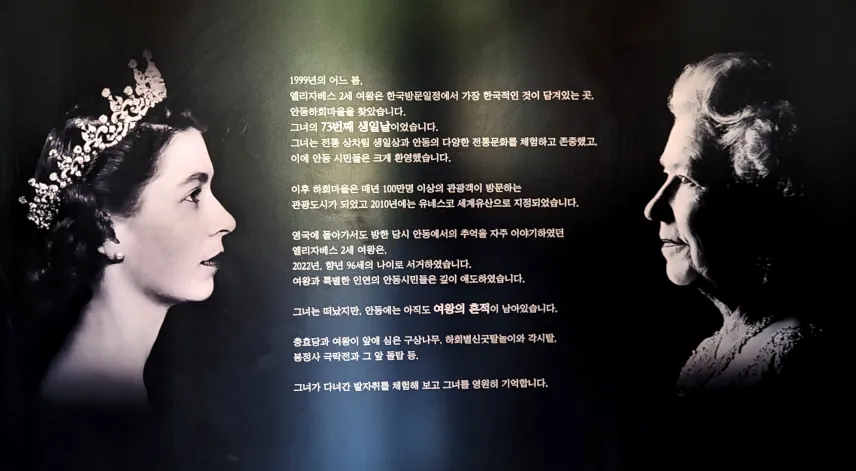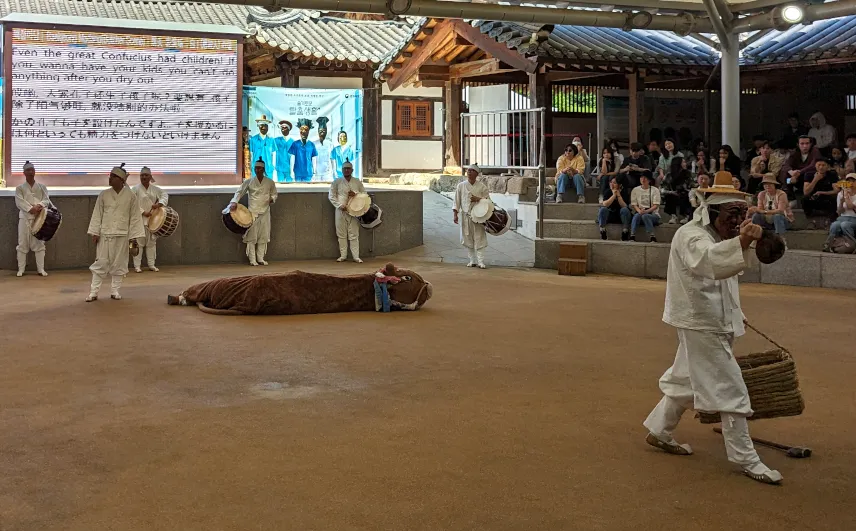
Hahoe Folk Village Travel Guide + Map (2024)
TL;DR
Currently, the most up-to-date travel guide to Hahoe Folk Village in South Korea!
When we started to plan our trip to South Korea, we immediately knew that we had to put Hahoe Folk Village on our itinerary. After all, UNESCO called Hahoe one of the “most representative historic clan villages” in South Korea and the Hahoe Mask Dance is unique.
Unfortunately, there’s not a ton of up-to-date information out there. We’ve written this Hahoe Folk Village Travel Guide to change that!
Hahoe Folk Village Travel Guide
What is Hahoe Folk Village
Hahoe Folk Village is one of the most famous folk villages in Korea. It is on the UNESCO World Heritage List and houses many cultural treasures.
Hahoe is a clan village where the Ryu clan has lived for 600 years – they still make up 70 percent of the villagers today! Traditional tile-roofed and thatched houses have been well preserved over this long period. The village is famous as the birthplace of the great Confucian scholars Gyeomam Unryong Ryu and Seoae Seongyong Ryu, who served as prime minister during the Seven Years' War with Japan.
The name Hahoe translates to "village surrounded by water": The village is surrounded by the Nakdong River in an S-shape. From the perspective of Feng Shui, Hahoe Village is shaped like a yin-yang symbol.

Can You Sleep in Hahoe Folk Village
The good news: You can sleep in Hahoe Folk Village. The bad news: As you will sleep in one of the historic Hanok houses, the overnight stay is on the pricier side.
If you are on a budget, we recommend staying in Andong. We stayed at Queen Motel Andong and could not recommend it more highly. As a bonus, it’s right around the corner from the bus stop where the bus to Hahoe leaves.
How to get to Hahoe Folk Village
Getting to Hahoe Folk Village by Public Transport
If you want to go to Hahoe Folk Village by public transport, you have to go through Andong (which is lovely by the way, we have written a complete Andong travel guide 😉)
From Andong, you can take bus No. 210 from Kyobo (central Andong) or Andong terminal. It takes roughly 50 minutes and you can pay with your T Money card. Here’s the bus schedule to Hahoe Folk Village:

Getting to Hahoe Folk Village by Tour
Tours to Hahoe Folk Village start both in Seoul and Busan.
Hahoe Folk Village Entrance Fee
The entrance fee for Hahoe Folk Village is 5000 ₩. This includes:
- Entrance to the village itself
- Hahoe Mask Dance Performance
- Hahoe World Mask Museum
- Shuttle bus

How to Get Around Hahoe Folk Village
You can walk from the ticket office to the actual village in around 15 minutes. Alternatively, the free shuttle bus is included in your entrance fee.
You can’t drive in the village itself so walking is your only option here.

Bucketlist2life tip: You can read about renting bicycles or golf carts in older blog posts but they were forbidden at the time of our visit.
16 Things to Do in Hahoe Folk Village
The main activity in Hahoe is just wandering around the alleys. Here, you can find many residences – some of which you can explore – as well as pavilions and exhibition halls.
1. Namchon/Yeomhaengdang Residence
Namchon Residence was built by Ryu Giyeong. Much of the house was lost due to a fire. Only three structures remain: The main building, the so-called Byeoldangchae, and a pavilion.
2. Juil Residence
Juil Residence was built in 1624 when Ryu Manha became independent of his parents' house. The house is characterised by a separation wall which was erected so that the inner space of the interior structure (Anchae) might not be seen from the yard.

3. Bukchon Residence/Hwagyeongdang Residence
Bukchon Residence was built by Ryu Doseong in 1862. It is a representative house for the nobilities of the Yeongnam area. The house is composed of an interior structure for women, an exterior structure for men, a structure for the servants near the gate, and a shrine.
Nowadays, there’s a guesthouse inside.
4. Yangjin Residence
Yangjin Residence was inhabited by Ryu Jungyeong (1515-1573). This is the great house in which the eldest sons of the Ryu family which originated from Hahoe Village lived from generation to generation.

5. Jakcheon Residence
Jakcheon Residence is characterised by the separation wall which was built in front of the inner room so that men in the exterior structure (Sarangbang) and women in the interior structure (Anchae) might not see or encounter each other.
6. Chunghyo Residence
Chunghyo Residence was inhabited by the scholar Ryu Seong Ryong. After his death, his followers and Confucian scholars helped Ryu Wonji, his grandson, build this residence in honour of his virtues.

7. Hadong Residence
Hadong Residence was built by Ryu Gyamok in 1836. The interior structure (Anchae) for women and the exterior one (Sarangchae) for men are connected into one. This type of house is called Mindori house with few only decorations to the rafters on the ceiling.
8. Goddess Samsin Tree
Goddess Samsin Tree is a 600-year-old zelkova tree located at the centre of a Hahoe Village. The tree is the residence of a goddess called Samsin who is in charge of pregnancy, childbirth and its fostering.

9. Yeongmogak Relic Hall
A small exhibition dedicated to the scholar Ryu Seong Ryong (1542-1607).

10. Wonji Pavilion & Binyeon Pavilion
Wonji Pavilion was built by Ryu Seongryong in 1573 when he came to his hometown Hahoe Village because of his father's death.
Binyeon Pavilion was built by Ryu Unryong in 1583. He used it as a library.

11. Queen Elizabeth II Memorial Hall
Photos and relics from the Queen’s visit in 1999 are exhibited here.

12. Buyongdae Cliff + Beach
Buyongdae Cliff overlooks Hahoe Village from the other side of the Nakdong River. We had read about a wooden ferry online but it was nowhere to be seen on the day of our visit so we didn’t make it across.
The beach in front of the cliff is a super nice spot to relax and maybe have a cheeky little pick nick.

13. Byeongsan Seowan Confucian Academy
The Byeongsan Seowon Confucian Academy was built in 1614 to worship Ryu Seong Ryong. It contains about 3000 books including a collection of books by Ryu Seong Ryong.
14. Hahoe Church
The Presbyterian Church at Hahoe Folk Village is worth the small detour. Firstly, the building itself is interesting, and secondly, the views from here are quite nice.

15. Hahoe World Mask Museum
Hahoe World Mask Museum is located at the entrance of Hahoe Village. More than 250 Korean and foreign masks are displayed here so you can compare different mask cultures around the world. The museum consists of five permanent exhibition halls and one special exhibition hall.
16. Hahoe Mask Dance Theatre
The Hahoe Mask Dance Theatre is an open-air theatre where the Hahoe Mask Dance Drama performance takes place every day between 2 - 3 pm.
As we loved the performance, we decided to give you more information below.

Hahoe Mask Dance Drama
If you have any chance, don’t miss out on watching the Hahoe Mask Dance Drama performance. We were absolutely blown away by it!
The Hahoe Mask Dance Drama is an Important Intangible Cultural Property and a collection of thirteen masks are a National Treasure. The drama is also called "Hahoe special ritual drama to the gods". It is performed at the request of the village deity in Hahoe and combines Korean shamanism with some of the major themes of Korean masked drama like social satire as well as the ridicule of Buddhist priests and the nobility.
The performance is a combination of music, dance, and spoken passages. In the background, there’s a screen with English translations as well as thorough explanations.
8 different episodes are presented:
- Shaman episode (Mudong madang)
- Lion episode (Juji madang)
- Butcher's episode (Baekjeong madang)
- Old widow's episode (Halmi madang)
- Apostate monk’s episode (Pagyeseong madang)
- Nobleman and scholar’s episode (Yangban and Seonbi madang)
- Wedding ceremony episode (Holrye madang)
- Wedding night’s episode (Sinbang madang)

Hahoe Folk Village Map
Where to Eat In Hahoe Folk Village
Inside Hahoe Folk Village itself, there are very few shops and cafes where you can buy (overpriced) snacks and drinks. We strongly recommend you bring a small pick nick with you – at least that’s what we did.
If you’re looking for a restaurant, your best option is around Hahoe Marketplace at the entrance of the village. Here, you can find local delicacies like Heotjesatbap and Andong Salted Mackerel.
For Andong Jjimdak, pre-ordering dinner at Chogajib Minbak comes highly recommended.

Disclaimer: This post contains affiliate links. If you use these links to buy something we may earn a commission. You would help us a lot if you do so. Thanks.



